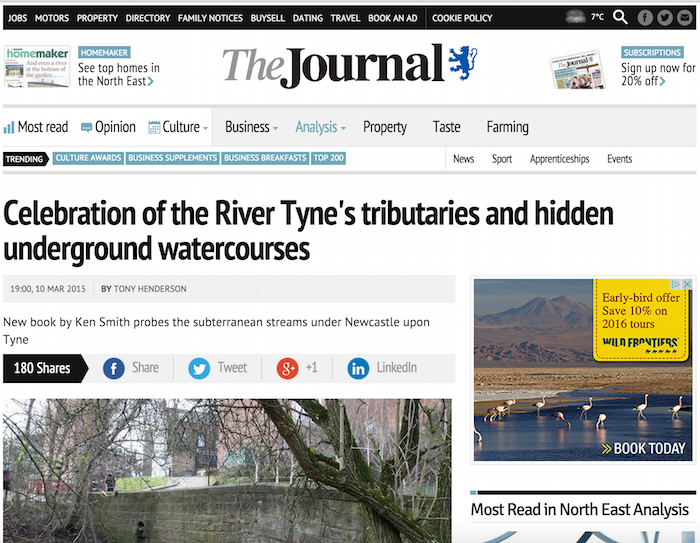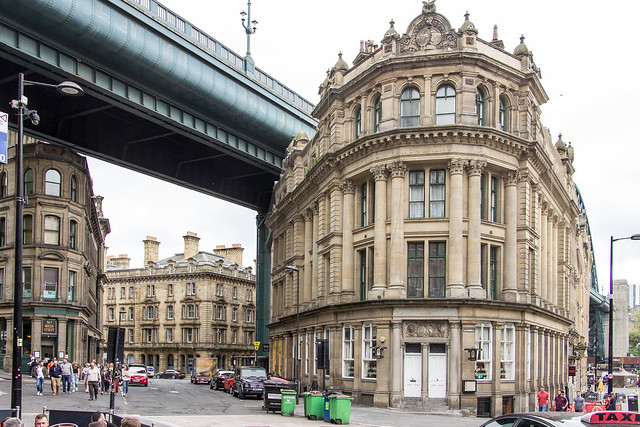Topics > People in History > William Parnell
William Parnell
William B. Parnell was an architect working in Newcastle in the 19th century. Little biographical detail is available about him.
His known works in Newcastle include:
- St Nicholas Buildings, Westgate Road / St Nicholas Street (1850)
- Exchange Buildings, King Street / Queen Street, Lombard Street, Quayside (1862)
- Princes Buildings, 1-23 (odd numbers) Queen Street / Akenside Hill (1863)
- Tyne Theatre - buit as the Stroll Cinema (1867)
- Pheonix House, Queen Street /Sandhill (c.1869)
- ?New Tyne Brewery, Bath Lane (1870)
Frank West Rich served as an apprentice to Parnell from 1863 to 1872. (The Directory of British Architects, 1834-1914: Vol. 2 - entry for Frank West Rich notes: "Articled to William Parnell from ca. 1863").
 The Tyne Theatre is considered to Parnell's finest work. Parnell is thought to have modelled it on an Italian theatre. In the 1860's there was a focus on Italian symbolism - reflecting a strong interest in Garibaldi's ideals and campaign to liberate Italy from oppression. Garibaldi visited Newcastle and Tynemouth, and some radical Tynesiders fought in Garibaldi's army.
The Tyne Theatre is considered to Parnell's finest work. Parnell is thought to have modelled it on an Italian theatre. In the 1860's there was a focus on Italian symbolism - reflecting a strong interest in Garibaldi's ideals and campaign to liberate Italy from oppression. Garibaldi visited Newcastle and Tynemouth, and some radical Tynesiders fought in Garibaldi's army.
David Wilmore, who worked on the restoration of the Tyne Theatre after it was damaged by in 1985, traced Parnell to an unmarked grave in Croydon - Parnell had left Newcastle because of ill health and died at the home of his niece in Croydon in 1886. Wilmore erected a commemorative gravestone in the shape of the proscenium arch at the Tyne Theatre in 2007, marking the 140th anniversary of the opening of the building.[1]
A resturant called "Dobson and Parnell" was opened at 21 Queen Street in 2019 - honouring Parell and his contemporary architect, John Dobson.

Co-Curate Page
Tyne Theatre
- "Theatre and opera house, later cinema; now theatre. 1867 by W.B. Parnell for Cowan. Bought by Oswald Stoll and opened as cinema in 1919. Italianate front of three storeys, five …

Co-Curate Page
St Nicholas' Buildings, St Nicholas' Street
- Overview Map Street St Nicholas Building is located on the corner of St Nicholas' Street and Westgate Road in Newcastle. It was built c.1850 by William Parnell in "Venetian Renaissance" style …

from https://www.questia.com/read/…
Tribute to Tyne Theatre Architect; the Man Responsible for the Tyne Theatre Has Been Saved from Anonymity. Tony Henderson Looks at a Fitting Tribute to One of Tyneside's Forgotten Heroes
- The Journal, November 22, 2007 (via Questia).
Added by
Simon Cotterill

Co-Curate Page
No. 18, Sandhill (Phoenix House), Newcastle
- Overview Map Street View Phoenix House is located on the corner of Sandhill and Queen Street in Newcastle, by the Tyne Bridge. It was built in c.1869 by William Parnell, …

Co-Curate Page
Princes Buildings, Newcastle
- Overview Map Street View Princes Buildings is a substantial block of buildings which straddle Queen Street (No.1-23), King Street (No. 2) and Akenside Hill (Nos 11-14) in Newcastle. They were designed …

Co-Curate Page
Exchange Buildings
- Overview Map Street View Exchange Buildings is a large block, incorporating No. 9-15 Lombard Street, No. 9 Quayside, No. 16 Queen Street and Nos. 6-10 King Street. Circa 1858 - …


Co-Curate Page
Tyne Theatre
- "Theatre and opera house, later cinema; now theatre. 1867 by W.B. Parnell for Cowan. Bought by Oswald Stoll and opened as cinema in 1919. Italianate front of three storeys, five …

Co-Curate Page
St Nicholas' Buildings, St Nicholas' Street
- Overview Map Street St Nicholas Building is located on the corner of St Nicholas' Street and Westgate Road in Newcastle. It was built c.1850 by William Parnell in "Venetian Renaissance" style …

from https://www.questia.com/read/…
Tribute to Tyne Theatre Architect; the Man Responsible for the Tyne Theatre Has Been Saved from Anonymity. Tony Henderson Looks at a Fitting Tribute to One of Tyneside's Forgotten Heroes
- The Journal, November 22, 2007 (via Questia).
Added by
Simon Cotterill

Co-Curate Page
No. 18, Sandhill (Phoenix House), Newcastle
- Overview Map Street View Phoenix House is located on the corner of Sandhill and Queen Street in Newcastle, by the Tyne Bridge. It was built in c.1869 by William Parnell, …

Co-Curate Page
Princes Buildings, Newcastle
- Overview Map Street View Princes Buildings is a substantial block of buildings which straddle Queen Street (No.1-23), King Street (No. 2) and Akenside Hill (Nos 11-14) in Newcastle. They were designed …








